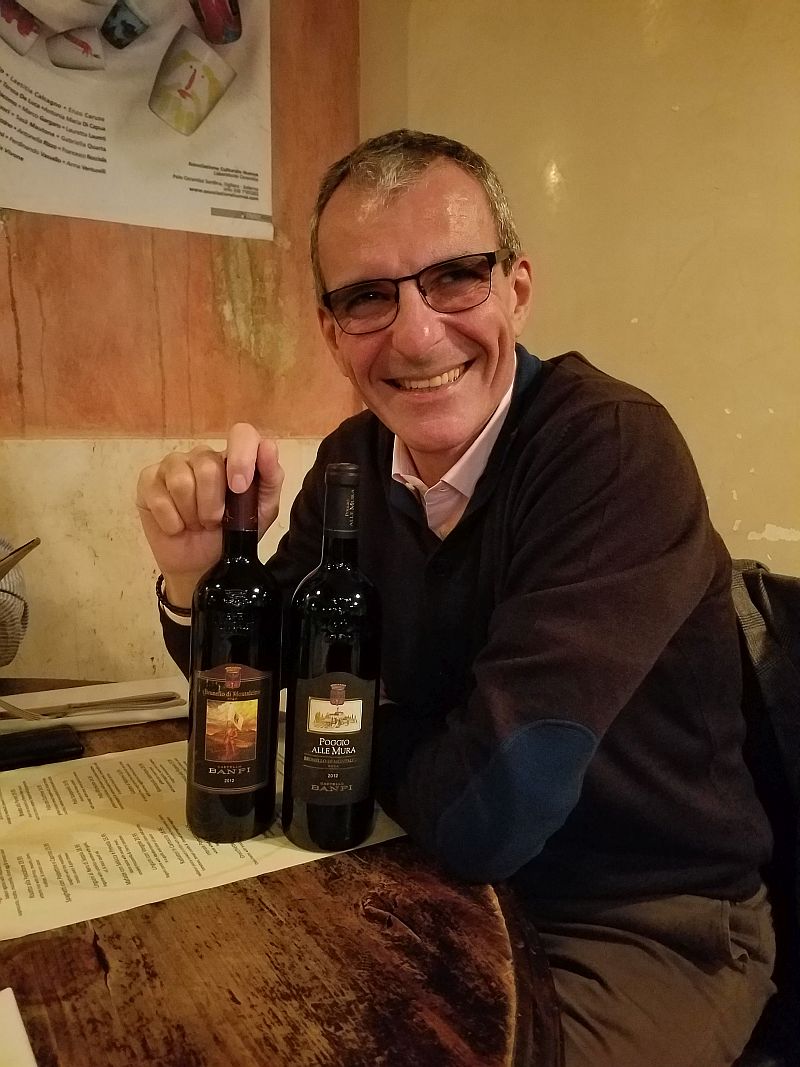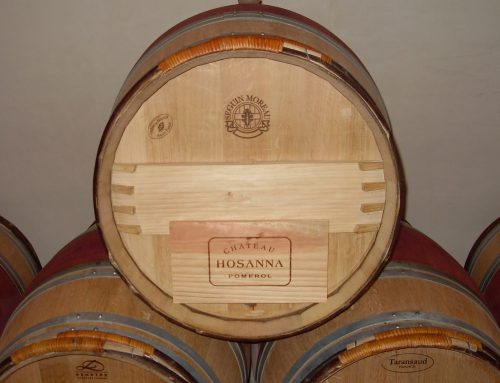Enrico Viglierchio with 2012 Banfi Brunello di Montalcino wines
How do you pronounce your last name,” I asked Enrico Viglierchio, as we sat down at Zero Otto Nove restaurant in Manhattan.
“I don’t even know how to pronounce my last name,” he replied with a laugh. “Sometimes when I make a reservation at a restaurant or hotel, I use my girlfriend’s last name, other times I use Banfi.” As the general manager of Castello Banfi estate in Montalcino, he’s allowed that little white lie.
Immediately, I sensed that regardless of the food, this was going to be one of my more enjoyable wine producer luncheons.
Until 1998, Viglierchio (vil-YER-kee-oh) worked at the 3M Company–then named the Minnesota Mining and Manufacturing Company, and best known for Scotch tape and Post-It Notes. Working in the financial department and the photo business, he said that he decided to leave in 1996 when the company choose not to pursue the new development of digital photography.
At first, he thought he would work in media, but a chance meeting with John Mariani, partner of Banfi Vintners, and Castello Banfi in Montalcino, changed his life. Mariani was looking for a replacement of a management retiree. And Viglierchio, whose experience was with international companies, was intrigued by a family-run business, as well as the wine business.
“I knew nothing about wine,” Viglierchio told me with a look of amusement on his face at the memory of what was an improbable meeting.
Next, Viglierchio had dinner at Barbetta, a classic Italian restaurant in New York City’s Theater District, with the other Marini family members in the business: John’s brother Harry, and their children, James and Christina. ”By the end of the dinner, I knew I wanted to work for them,” he said without a trace of doubt or regret.
While the waiter poured the 2012 Castello Banfi Brunello di Montalcino at our lunch, Viglierchio reflected on his career change, noting the differences. “The wine business is a completely human relationship business.”
I inhaled the soy and black-fruit aromas while Viglierchio explained that the 2012 vintage in Montalcino was the driest vintage ever recorded. I was swirling around my mouth the blackberry and black-cherry-flavored fruit with gripping tannins when he said that the older vines produced good fruit, but those younger than 10 year old were stressed, and much of the fruit was not used in the Castello Banfi 2012 Brunello di Montalcino. I thought the wine displayed Brunello’s usual tannic personality at this young age and awarded it an unstressed 90 points. It will be delivered in January. Based on recent vintages, expect a price range of $50 to $80.
Viglierchio poured the 2012 Castello Banfi Poggio alle Mura Brunello di Montalcino as he explained that, in 1992, the vineyard around the Poggio alle Mura castle was planted with a selection of three sangiovese clones, resulting from a decade of research by Banfi’s viticulturist, winemaker and professors in the agriculture department at the University in Milan.
As I angled my glass of the 2012 Poggio alle Mura toward my nose, a pronounced black-fruit and vanilla scent filled the space between the glass and me. I paused and Viglierchio said, “Wine is not only a product, it is a style of life and a statement about the history of the people who make the wine. This is the emotional relationship of the wine and the culture of the wine.”
I kept my glass still as I thought about the history, vineyards and wines of Castello Poggio alle Mura sitting on its hilltop since 1438. Wars with the Medicis, economic upheavals and years of great harvests were etched into its hillside in southwestern Montalcino.
I didn’t tell Viglierchio that my history contains the consumption of a fair share of Poggio alle Mura, most recently the 2006 through 2009 vintages, which created my own relationship to the 2012 Poggio alle Mura.
I understood its intense blackberry flavor and vanilla lining from two years of aging in French oak barrels would mellow; I foresaw the day when the tannins would become friendlier. I thought “I will really enjoy the 2012 Poggio alle Mura when it has five or six years of evolution. I will want it in autumn and next to a bowl of penne with duck ragout.” 93 points. The wine is scheduled to arrive in spring 2017; expect a price range of $75 to $110.
While we waited for the server to bring new glasses, Viglierchio recounted his first months with Banfi, punctuated with bouts of laughter. “I had to learn to spit, and I had to learn to taste and not drink.” Wine was not part of his day at the 3M Company.
New glasses were set on the table and the 2010 Castello Banfi Poggio alle Mura Riserva Brunello di Montalcino was poured into mine. Poggio alle Mura is a single-vineyard wine, or what Italian winemakers like to call a “cru,” and the riserva is made from the first selection of the vineyard.
As with all Brunellos, the riserva must be only sangiovese, but it has to age six years from the harvest date, as opposed to five years for the nonriserva, or “normale,” as it is called in Italian wine dialect.
From its blackberry hue to its integrated tannins and black-flavored fruit, the 2010 Poggio alle Mura Riserva is as soft and elegant as a Loro Piana cashmere scarf or jacket. The refinement reflects not only the outstanding quality of the 2010 vintage in Brunello, it also includes the collective wisdom of head winemaker Rudi Buratti’s 33 years at Banfi.
Buratti’s institutional memory is critical to Banfi. It protects great vintages like 2010 from being manipulated for a marketing style, and recalls the way to elevate wines in lesser years. Without doubt the 2010 Poggio alle Mura Riserva is a wine you should cellar until 2020, then enjoy bottles of it for decades. 97 points. Currently available at $120 to $140.
Enrico with the 2010 Castello Banfi single-vineyard Brunello di Montalcino wines (aka crus)
While we watched the waiter remove the cork from the bottle of the 2010 Castello Banfi Poggio all’Oro Riserva Viglierchio said “In my first months, I had to learn how to taste for certain parameters like tannins, differences in vineyards, and the future of the wine, not the present.”
The single-vineyard Poggio all’Oro is about 1,500 feet from the Poggio alle Mura vineyard and sits at the top of a knoll (its name means golden knoll, whereas the other defines the hill at the village walls) 820 feet above sea level. The different soil generated a noticeable minerality, and grapes yielding more restrained black-flavored fruit in the 2010 Poggio all’Oro Riserva. Austere tannins, forthright acidity, and the alcohol’s heat on the palate sent a message that this was not a wine for the present. But the future will be bright after the 2010 Poggio all’Oro Riserva ages quietly in your cellar until 2022. Then, you’ll see that its firm structure is a solid friend. 95 points. $125 to $189.
We set aside the glasses of the young wines when the bowls of pasta arrived, and poured the excellent 2007 Castello Banfi Brunello di Montalcino. Born in a year the wine gods blessed, its black-cherry color and flavor and integrated tannins were introduced to me in 2012. It is softer and rounder today.
A few retailers still carry the 2007 Castello Banfi Brunello di Montalcino, but unless you know the store kept it in a temperature-controlled wine unit, and out of glaring lights and sunshine, I would recommend buying it only from a restaurant that cellars its wine. 93 points. Retail price is $50 to $70.
Oh, as for the lunch itself. Not nearly as enjoyable as Enrico and the wines of Castello Banfi.









Leave A Comment